One potentiometer isn’t the same as another, if they were, why would some be marked with an A and others be marked with a B (and why would others have a different letter on them)? Like so many things to do with electronic components, the A and the B is a simple shorthand to say there is a difference in the component. But what does it mean?
Here’s the simple difference between A and B potentiometers:
- A potentiometer: logarithmic taper
- B potentiometer: linear taper
If you already know what that means and you were just trying to remember which is which, there you go. If you’d like a more in depth explanation of what these tapers are, read on and I’ll explain.
But first, a couple things for background information. If you want more information on potentiometers in general, have a look at my guide to potentiometers. If you’re familiar with pots, but you want to know about different ways they’re wired, have a look a my article on potentiometer wiring.
What Is An “A” Potentiometer?
An A potentiometer is also known as a logarithmic (log) taper or audio taper. It’s called this because the level of resistance (the taper) the potentiometer gives follows a logarithmic curve.
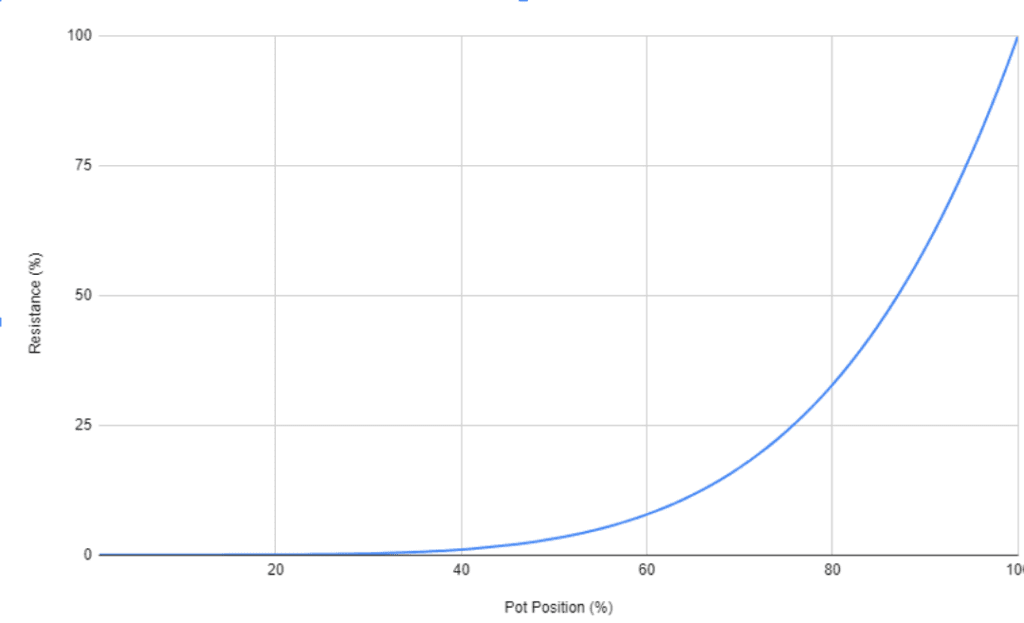
Although this is the theoretical curve that an A/log/audio potentiometer follows, in actual practice, it generally follows two linear lines, one that increases resistance slowly until the potentiometer is at 50%, then the resistance increases quickly. Like this.

For the maths people out there, you’ll note that this isn’t actually a logarithmic curve, it’s an exponential curve. Naming conventions are weird. Especially because (spoiler alert) inverse log pots follow an actual log curve.
But, this anomaly is down to how the graph is plotted. As you can see on the graph, the position of the potentiometer (how far it’s turned to the right) is on the x-axis, while the resistance is on the y-axis. This is because the potentiometer is what the user interacts with, making the resistance a function of that interaction. This will make a bit more sense in the next section.
What Are “A” Potentiometers Good For
As mentioned, an A potentiometer is also called a logarithmic or audio taper potentiometer. I’ve already explained why it’s sometimes called a logarithmic taper potentiometer, but perhaps the other name, audio taper, explains one of the common uses for A pots.
Audio taper pots are often used in volume control.
This is because the curve of an audio taper pot is similar to how we hear things on the decibel scale. Small changes in volume are perceived as larger when a noise is quieter then, as things get louder, those changes in volume aren’t perceived as far apart. Flipping the graph you saw earlier show show potentiometer position as a function of resistance, we have the same graph as the one for decibels (and a proper logarithmic curve).

Pro tip: if you can’t remember which one is which, just remember “A for Audio.”
So, to that end, logarithmic (A) potentiometers are used in situations where you want a small change in resistance when the potentiometer knob is lower (more to the left) and larger changes in resistance as the knob is turned up. This works well for:
- Volume: as already mentioned, because it’s how we perceive sound.
- Effects where you want fine control for lower levels and large changes for higher levels.
Enjoying This Component Guide?
Learn more about potentiometers and other guitar pedal components.
What Is A “B” Potentiometer
A B potentiometer is also known as a linear potentiometer. Why? Because its taper follows a linear path, that’s why. What this means is if you turn the knob 20%, it gives you 20% resistance. If you turn it 50%, 50% resistance. 75%, 75% resistance. The graph looks like this:

This is obviously pretty simple to get your head around and kind of how one would naturally think a potentiometer works. And linear potentiometers are quite common.
What Are “B” Potentiometers Good For?
B, or linear, potentiometers are useful for any application where you want a consistent change in resistance as you turn the dial. This is pretty much any situation other than volume control.
This is especially the case when you’re adjusting the level for an effects pedal’s actual effect. If you’re trying to adjust the amount of fuzz or distortion, you want the same amount of increase in fuzziness regardless of whether you’re at the top or the bottom of the potentiometer, a lot of the time at least.
However, as mentioned, some effects pedals will use a logarithmic pot to adjust the effect level. Staying with distortion, this may be good when using a specific transistor or op-amp that increases gain quickly then tapers off. It depends on what the pot is getting paired with.
There Are Other Types Of Potentiometers
While logarithmic and linear potentiometers are certainly the most common, at least in guitar pedals, there are other pots out there as well. These include:
- C potentiometers: these follow an inverted logarithmic curve, so the opposite of log pots. These change quickly at lower levels then have less change towards the top. If you are having trouble finding a reverse log pot, don’t replace is with a log pot. You’re better off using a linear pot in a pinch.
- W potentiometer: a W taper is logarithmic for the first 50% of the potentiometer’s turn, then reverse logarithmic for the last 50%. So on the extremes you get a small change for a large turn while in the middle you get a larger change for the same turn.
- G potentiometer: a G taper is the opposite of the W taper. It’s a reverse log at first then a proper log for the second half.
- For both W and G taper pots, again, you’re better off substituting these with a linear pot if you can’t find them. Both a W and G taper are very roughly linear, so there won’t be a huge difference. Obviously get the right part if you can, but if you can’t, linear is better than nothing.
Get Building
Now you know all about A and B potentiometers. If you’re following schematic, it’s usually specified what kind of pot to use, but if you’re looking to modify a pedal (or any other type of electronic), hopefully this article has helped you in selecting the right thing.
Related posts:
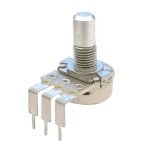 Ultimate Guide To Potentiometers In Guitar Pedals: What They Do And How They Work
Ultimate Guide To Potentiometers In Guitar Pedals: What They Do And How They Work
 Potentiometer Wiring: How To Wire A Potentiometer
Potentiometer Wiring: How To Wire A Potentiometer
 How Do Guitar Pedal (And Guitar) Volume Knobs Work?
How Do Guitar Pedal (And Guitar) Volume Knobs Work?
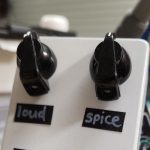 How Does A Drive, Gain, Or Distortion Knob Work?
How Does A Drive, Gain, Or Distortion Knob Work?
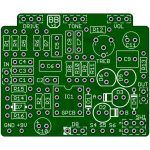 What Is A PCB?
What Is A PCB?
 How To Wire A Guitar Pedal DC Power Jack
How To Wire A Guitar Pedal DC Power Jack
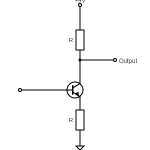 What Is Transistor hFE?
What Is Transistor hFE?
 The Difference Between SPDT, DPDT, And 3PDT Switches And How To Use Them
The Difference Between SPDT, DPDT, And 3PDT Switches And How To Use Them
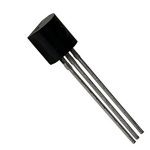 The Difference Between Silicon And Germanium Transistors
The Difference Between Silicon And Germanium Transistors
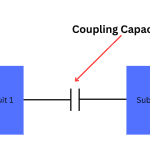 What Are Coupling Capacitors?
What Are Coupling Capacitors?
